Snapdragon – planting and care, growing from seeds
 Dragon flowers, or snapdragon, or antirrhinum (lat. Antirrhinum) is a genus of herbaceous plants in the family Plantaginaceae that involves about 50 species of perennials including trailing ones. It is native to the warm climate zones and grows mainly in North America. The Russians call this plant "doggies", the British – "snapdragon", the French – "wolf mouth", and the Ukrainians – "little mouths." Its name was derived from the Greek word "antirrinum" that means "nose-like". In Ancient Greek mythology, the first Hercules’ labour was to kill the Nemean lion that was famous for its ferocity and invulnerability. The Goddess Flora gifted Hercules with a beautiful flower that she created in honor of his victory and that she called a "lion's mouth." Since then, in Greece it has become a tradition to gift snapdragons to heroes.
Dragon flowers, or snapdragon, or antirrhinum (lat. Antirrhinum) is a genus of herbaceous plants in the family Plantaginaceae that involves about 50 species of perennials including trailing ones. It is native to the warm climate zones and grows mainly in North America. The Russians call this plant "doggies", the British – "snapdragon", the French – "wolf mouth", and the Ukrainians – "little mouths." Its name was derived from the Greek word "antirrinum" that means "nose-like". In Ancient Greek mythology, the first Hercules’ labour was to kill the Nemean lion that was famous for its ferocity and invulnerability. The Goddess Flora gifted Hercules with a beautiful flower that she created in honor of his victory and that she called a "lion's mouth." Since then, in Greece it has become a tradition to gift snapdragons to heroes.
Snapdragon flowers have been cultivated for about five hundred years, and breeding works were started by German scientists in the XIX century. Today about 1,000 varieties of snapdragon are grown in the gardens of the world. The most interesting fact is that the basis of this diversity of species and hybrids is a single species – common snapdragon (Antirrhinum majus).
Description of snapdragon flower
Snapdragon plant is a semi-shrub or herbaceous plant with straight, branched, green, thinly-furrowed stems, reaching from 6 to 40 inches in height and forming pyramidal bushes. The upper leaves of snapdragon are alternate, the lower leaves are opposite. The leaves have elongated-oval or lanceolate shape, the color is from light green to dark green with red veins. Flowers are fragrant, rather large, irregular, bilabiate. Depending on the variety they can be simple or double. The flowers are collected in spicate inflorescences. The color of flowers can be white, yellow, pink, pale yellow, all shades of red. There are also two-color and even three-color varieties. The fruit is a dithecal capsule, containing numerous small seeds (0.04 oz contains from 5,000 to 8,000 seeds). Snapdragon blooming usually starts in June and lasts until frost.
While snapdragon is perennial in the wild, in horticulture it is mostly grown as an annual plant, but if the care is good and conditions are favorable, cold-hardy snapdragon can successfully overwinter in the garden and bloom the next year. In the garden design, antirrhinum is grown as a skirting plant, although snapdragon looks equally beautiful growing on the flowerbed and in the set of flowers against the background of a green lawn. Snapdragon is mostly used to decorate balconies and terraces. Flower growers especially like trailing varieties of snapdragon that can be grown in the hanging baskets to decorate terraces.

Growing of snapdragon from seeds
Sowing of snapdragon seeds
Snapdragon is propagated by generative and vegetative ways. Seeds of snapdragon retain the ability to germinate for several years. If you live in a warm climate, you can grow snapdragon from seeds, sowing them right into the soil, and the shoots will appear in two and a half or three weeks, without suffering from a light night cooling that is usual for spring. But in areas where warmth comes gradually, it is better to use the seedling method of growing of snapdragon. How to grow snapdragon from seeds by seedling method? This process is neither difficult nor laborious.
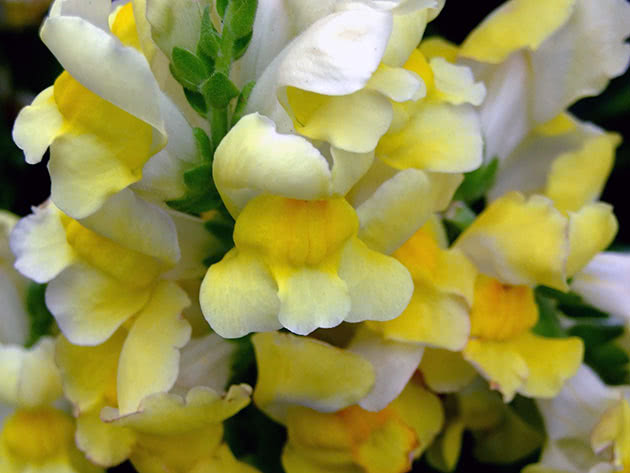
To sow snapdragon seeds you should do the following: at the beginning of March, take an earthen saucer with a diameter of at least 4 inches and with drainage holes and fill it with large-grained sand, on the top of the sand add compost soil mixed with sand, tamp the soil, level it, spray it and sprinkle seeds mixed with sand on its surface. Then cover the seeds with a thin layer of the same substrate, moisturize it by a finely dispersed spray gun and cover the pot with glass. Every day you should remove the condensate from the glass, airing out the seedlings, and, if needed, spray the soil. At a temperature of 73 ºF and with a moderate moisture content of the substrate, the shoots will emerge in a couple of weeks. As soon as this happens, put the earthen saucer in a bright place without sunlight for the shoots not to overstretch, and as soon as most of shoots appears (3-4 days later), remove the glass.

Seedlings of snapdragon
At first seedlings grow slowly, and your task during this period is to arrange the proper moistening of the soil by watering the soil in the morning so the moisture is abundant, but not excessive, as this can lead to seedling disease "black leg". "Fallen" sprouts need to be removed with tweezers, and the place where they grew up should be powdered with a crushed coal or sprinkled with a small amount of tempered and cooled river sand. After the appearance of a pair of true leaves ( not cotyledonous leaves) the seedlings are pricked out into a container or box, placing them apart to grow freely. You can plant seedlings in individual pots, or, for example, prick out three sprouts in larger pots. Put the pricked out seedlings in a bright place, protecting them from direct sunlight, and start gradually getting them adapted to the environment and temperature in which they will have to be after transplanting into the open ground: open the window for a while, but avoid a draft. After developing 4-5 leaves the central shoot of each seedling should be pinched to promote tillering, but if the lateral shoots also grow actively, pinch them as well.

Planting of snapdragon
When to plant snapdragon
Grown, strengthened and adapted seedlings are planted in the open ground in late May – early June. You should not be afraid of the last cold nights: your young "dragons" will tolerate them easily. The planting site for snapdragons can be both sunny and slightly shaded, however it must be protected from strong wind and with well-draining soil. Soil must be light and nutritious. The best soil for snapdragon is a mixture of sand, compost and peat in approximately equal proportions. The optimum hydrogen index of soil for snapdragon is 6-8 pH.

How to plant snapdragon
Planting of snapdragon flowers is carried out according to the following scheme: tall varieties are planted at a distance of 16-20 inches from each other, medium-sized varieties are planted at a distance of 12 inches, short varieties are planted at a distance of 8 inches, dwarf varieties are planted at a distance of 6 inches. As soon as snapdragon takes root, it starts growing quickly and turns into a heavily blooming bush. It should be noted that the planting of snapdragon is carried out in a well-moistened soil.

Care for snapdragon
How to grow snapdragon
This plant is undemanding and needs only what any garden flower needs: watering, loosening the soil, weeding and feeding. Watering is carried out only when there is no rain, but not in the evening. Loosening and weeding should be done on the day after watering, or on the same day in the evening. Tall varieties of snapdragon should be tied to the support stick. Wilted flowers should be removed, so that the plant does not waste resources on them. If you want your snapdragon to have a long flowering season, do not let it produce the seeds and remove the flower stalk as soon as the last flowers wilt. The flower stalk should be cut off below the lowest flower for new flower stalks and flowers to appear. Once the plant takes roots after planting, it should be fed with mineral and organic fertilizers, second dressing is performed when snapdragon starts forming buds, and in this case you should use a carbamide solution, potassium sulfate and superphosphate at the rate of one tablespoon of each ingredient per 2.2 gallons of water.
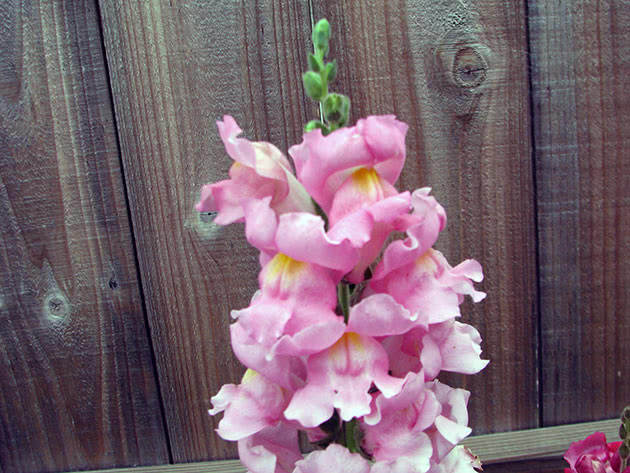
Pests and diseases of snapdragon
Sometimes red spots of rust appear on the plant. Snapdragon can be affected by late blight, blackleg, gray or root rot. Infected plants should be immediately removed and destroyed, and the soil they grew in must be treated with a fungicide. Insect pests that can attack snapdragon are scales, larvae of flies, caterpillars and butterflies laying eggs. It is always easier to take preventive measures than to treat a disease that has already developed or to control the insects that have settled on the flowers, so follow the plant caring recommendations, remove the diseased or pest-affected plants timely, do not allow the plants to grow too close to each other, arrange a proper irrigation of the site, pour water under the root of the flowers, not on the leaves, and snapdragon will be disease and pest resistant.

Snapdragon after flowering
Snapdragon can bloom until autumn frosts, but when deep autumn comes and if you grow snapdragon as a perennial plant, cut it off leaving 2-3 inches above the ground, and cover the area with peat or sawdust or dry foliage as mulching will help plants survive the winter. If you grow snapdragon as an annual plant and in order to avoid self-sowing during the flowering period, you should remove the wilted flowers timely, and when all flowers on the flower stalk fade, trim the flower stalk as low as possible. This must be done for the seeds not to ripen and scatter over the ground. When the autumn comes, dig over the soil and burn the remains of plants to destroy pests that have settled on them.

How and when to collect the snapdragon seeds
Seeds of most garden plants are harvested when they are fully mature. But the seeds of snapdragon should be collected at the stage of incomplete maturity for them to ripen in a dry room with a good ventilation. They are collected in a long paper bag. The seeds are collected when the fruits on the lower part of the flower stalk are ripe: the upper part of the flower stalk on which the fruits are still green is cut and thrown away, and the rest of the flower stalk is wrapped by a paper bag, tied with a thread below the fruit, and cut off below the thread. The turned up bag is suspended in a warm, dry room for the seeds to ripen and fall out from the capsules into the bag. Then they are placed in cardboard boxes and stored at a temperature of 37-41 ºF, avoiding possible ingress of moisture.
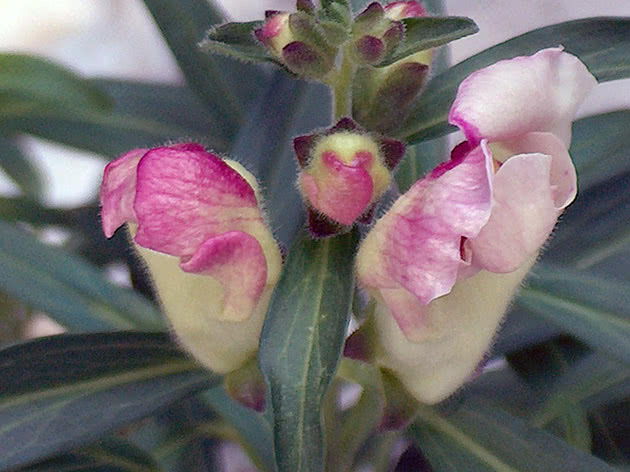
Species and varieties of snapdragon
Today in professional floriculture there are several classifications of snapdragon, and the most popular of them is based on the height of plants. On this basis, the varieties are divided into five groups:
– gigantic snapdragons with a height of 35 to 51 inches. The central shoot of the plants of this group is much higher than the shoots of the second order, shoots of the third order are absent. The varieties are: “Arthur” is cherry-colored, 35-37 inches tall; “F1 red XL” and “F1 pink XL” are 43 inches high, red and pink, respectively;
– tall snapdragonsthat are from 24 to 35 inches. They are grown as cut flowers or as a vertical accent in a mix of flowers. The lateral shoots are much lower than the central one. Tall snapdragon as a cut flower remains fresh up to a week or longer, the most fragrant snapdragons are varieties of yellow shades. Popular varieties are: “Anna Herman” is a soft pink snapdragon; “Canary” is a bright yellow variety; a mixture of varieties “Madame Butterfly” is a double snapdragon of various shades and others;
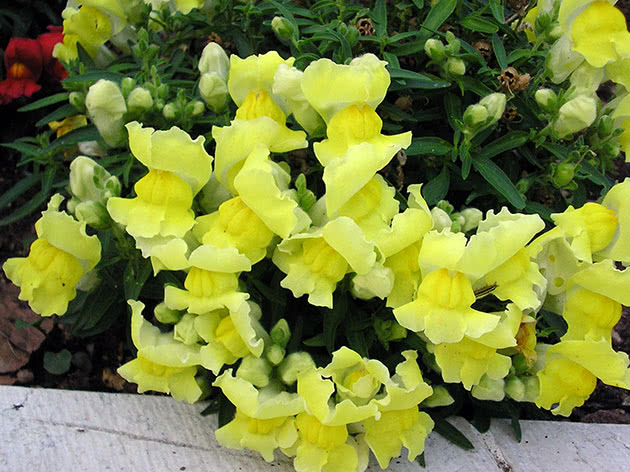
– semi-high, or medium-sized,snapdragons are 16-24 inches in height. These are universal varieties, grown both as a flower bed decoration, and for cutting. They are characterized by a strong branching. A distinguishing feature of the varieties of this group is that the central shoot is slightly higher than the lateral shoots. The varieties are: “Golden Monarch” is a yellow-colored snapdragon; “Ruby” is a bright pink snapdragon; “Lipstick Silver” has a pinkish white hue;
– short snapdragons are from 10 to 16 inches in height, grown for flower beds or as a skirting plant. These varieties have many flowering shoots of the second and third order, the main shoot is at one level or slightly lower than the shoots of the first order. The varieties are “Hobbit”, “Tip-top”, trailing hybrid “Lampion”;
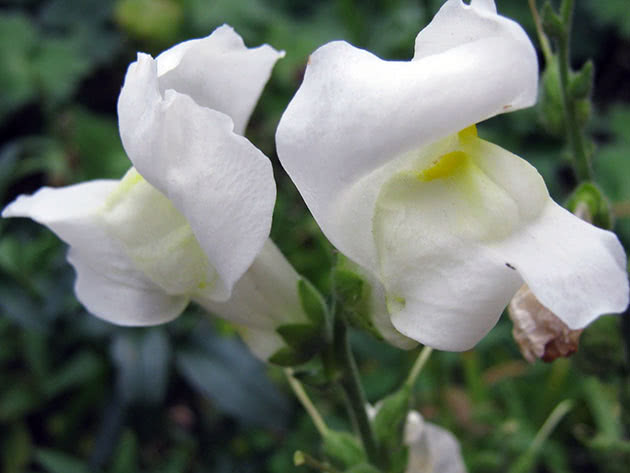
– dwarf snapdragons are 6-8 inches in height, grown as skirting plants, for carpet beds, rock gardens and garden beds. They are also grown as a potted plant. These varieties differ by a strong branching up to the shoots of the third and fourth order, the main shoot is usually lower or at the level of shoots of the second order. The varieties are: “Sakura flowering” is a pinkish-white variety with a spot; “Candy Showers” is a trailing snapdragon.
In addition to this classification there is no less popular classification of Sanderson and Martin for cutting varieties of the year-round cycle, but it is of interest only to those for whom growing of snapdragon is not a pleasure or an aesthetic need, but a means of earning.
